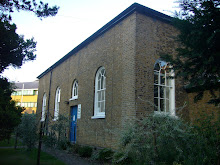1555 Uxbridge having become protestant during the reign of Edward VI remained so when the catholic queen "bloody" Mary had three martyrs burned at the stake at Uxbridge.
1603 there were 176 deaths from plague, more than 10% of the town population.
1625 Plague in the town again
1642 Parliamentary troops marched through the town and Jehemiah Wharton, one of the party, recorded that this day the communions rails of Uxbridge... were, with the service book, burned.
1645 Negotiations between the forces for the King and the forces for Parliament took place at Place House (later the Crown and Treaty Inn).
There were 32 men for each side, the Royalists taking the south side of the town and the Crown Inn for their HQ, and the parliamentary forces taking the north side and the George Inn for their HQ.
1647 Parliamentary HQ in Uxbridge: the new Model Army set up camp in Uxbridge. On this occasion, Cromwell stayed at the Crown Inn.
164? George, Lord Chandos, owner of the tolls and market rights killed Mr Compton, brother of Lord Northampton and fled to the continent.
1649 King Charles I beheaded
1652 George Fox has great success in the North.
1652 there was a pillory standing in Windsor Street Green in Uxbridge
1655 Francis Howgill, friend of Edward Burrough, wrote a letter to Cromwell. Some of Cromwell's servants were convinced by it, including Theophilus Green, who attended meeting at Uxbridge.
1657 About a thousand friends were in prison for their beliefs
1658 Edward Burrough, a pioneer of the Quakers, was holding meetings in the house of William Winch. Burrough established a monthly meeting (Longford Monthly Meeting) but by the end of 1658 had lft the district.
1658 Cromwell dies; son Richard takes over the Protectorate.
1658 John Sands wrote to George Fox for guidance and got a long reply addressed to the people of Uxbridge in 1659.
1659 Vicars of Hillingdon and Colnbrook engaged in public dispute with Quakers at West Drayton
1660 Meetings being held at the house of Nicholls (probably William Nicholl), Robert Hall, and Hugh Butler.
1660 Samuel Pepys begins his diary. Intends to go to a Quaker meeting but goes to the wrong tavern and misses the meeting.
1660 Restoration of Monarchy.
1662 George Pitt married Lord Chandos's widow and filed a suit for return of the market tolls.
1665 Cases of bubonic plague in the town.
1666 Great Fire of London
1667 William Penn becomes a Quaker, and is arrested
1699 By 1669 meetings were being held in three houses, organised by Uxbridge tradesman Timothy Fry, Edward Swift, Cooper, Richard Hale, collar maker. The one held in William Nicholls house was probably the most important of the three.
1669 William Penn was released
1671 William Penn was imprisoned for preaching, from February to July
1689 William Penn was arrested for treason against William and Mary
1691 George Fox dies.
1701 Waterworks was constructed in he town by John Yarnold. Water was laid on to the top of the town in the morning, and the bottom of the town in the afternoon one day and the reverse the following day
1750 onwards the County Court met alternately at the George in Uxbridge
1769 Road from Tyburn to Uxbridge is 14 miles, six furlongs, 37 poles. Busiest road in the kingdom, at the end of the 18th century it is notoriously bad and difficult to travel.
1769 Enclosure Acts meant open fields were enclosed with hedges. Land which had been under arable crops were enclosed and the fields put under grass. Demand for hay in London brought prosperity and armies of workers were brought in at hay cutting time.
Carts leaving Uxbridge at 3 am in the morning would return 7 pm at night because although only 15 miles, the roads were so bad.
1770 a fire engine was purchased by the town
1775 the Town Workhouse had 60 paupers
1782 population of Uxbridge s 1712 people in 366 houses
1785 Old Market house in Uxbridge demolished
1788 New Market house constructed at a cost of £3000, £2000 coming form the Quaker Thomas Hull
1791 Bank established in Uxbridge by Norton and Mercer
1793 The Grand Junction canal was started
1795 Relief of the poor cost the town £450 per year, paid to Joseph Packer
1796 One of the town's mills, owned by John and Nicholas Mercer, was destroyed by fire.
1798 Grand Junction canal reached Uxbridge
1798 Copper Mill established.
1799 or 1800 The water supply from the waterworks ceased. For a time water was provided by watercarts until the lords of the Manor dug three wells... one at the George Inn, another at the corner of St Margaret's church and a third opposite the Rose and Crown.
1801 population of Uxbridge is 2111 people in 375 houses
1803 the Town workhouse had 76 inmates.
1803 By then 121 men employed by Mines Royal Copper Co
1806 New bank established by Hull, Smith and Norton
1811 Population of Uxbridge is 2411 in 435 houses
1817 Meeting House rebuilt and burial ground enlarged.
1818 the Curfew bell was still sounding twice a day, at 5 am and 8 pm. It signaled to cover the fire.
1823 Elizabeth Fry (1780-1845) mentions coming to Uxbridge meeting in her journal
1833 some streets were lighted by gas.
RF established a camp on the north side of Uxbridge Road.
1960s Brunel University moved from acton to Uxbridge.
1962 by then the successive councils had erected 4702 dwellings in the borough of which approximately two thirds were sited in Hillingdon old parish.
There were also 2000 acres of open spaces, parks and recreation grounds, representing approximately 20 per cent of the area of the borough, including nearly 80 a of permanent and temporary allotments.
1965 new Borough of Hillingdon was formed.
Tuesday, September 23, 2008
Subscribe to:
Post Comments (Atom)

No comments:
Post a Comment